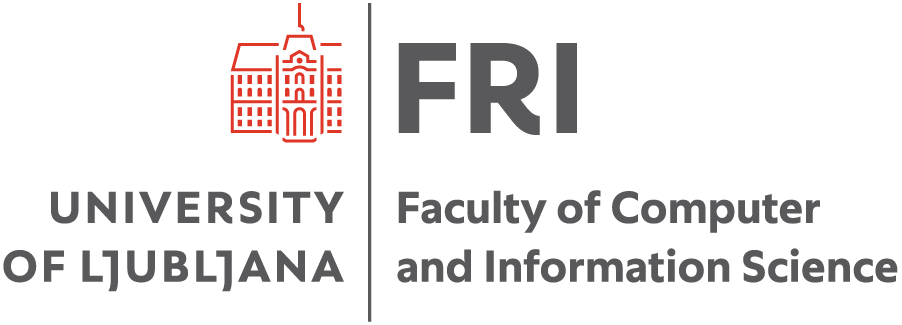Current UL FRI master students interested in collaboration with JRC may find relevant exemplary final thesis topics below. Working on these topics may also lead to an on-site paid traineeship at JRC in Ispra, Italy. If interested, please contact a corresponding thesis mentor.
1. Multi-task learning for joint face recognition and morph attack detection
Contact/Supervisor at FRI: Peter Peer (peter.peer@fri.uni-lj.si)
Contemporary deep face recognition models have recently been shown to be highly susceptible to spoofing attacks. Especially difficult to detect are morphing attacks, where an enrolled and an impostor face are morphed. Because of the mixture of the two faces both are recognized as genuine, despite the fact that only one is known to the system. To address these issues the research should look at multi-task methodologies for training face recognition models, where the multi-class face recognition task and the binary morph attack detection task are used jointly as the learning objective. Different aspects of the trained models should be studies, such as the performance of the feature representations learned with the model as well as the robustness of the learned representations to spoofing attempts
References:
[1] Mohammadi A, Bhattacharjee S, Marcel S. Deeply vulnerable: a study of the robustness of face recognition to presentation attacks. IET Biometrics. 2017 Oct 3;7(1):15-26.
[2] Gomez-Barrero, M., Rathgeb, C., Scherhag, U., & Busch, C. (2017, April). Is your biometric system robust to morphing attacks?. In Biometrics and Forensics (IWBF), 2017 5th International Workshop on (pp. 1-6). IEEE.
[3] Scherhag, U., Raghavendra, R., Raja, K. B., Gomez-Barrero, M., Rathgeb, C., & Busch, C. (2017, April). On the vulnerability of face recognition systems towards morphed face attacks. In 2017 5th International Workshop on Biometrics and Forensics (IWBF) (pp. 1-6). IEEE.
2. Face modification using gradient ascend on input images
Contact/Supervisor at FRI: Peter Peer (peter.peer@fri.uni-lj.si)
The goal of the work is to build procedures that can alter the appearance of facial images by exploiting techniques commonly used for visualizing layers of convolutional neural networks. Specifically, the research should look at different loss functions that can be applied to different layers of CNN models and try to minimize the loss by performing gradient ascend on the input images. The gradient ascend method should alter only the facial area in the image and leave all other parts intact. The altering procedure should be controllable through some properly chosen regularizer that can be added to the loss with the goal of influencing the appearance of the modified face images.
References:
[1] Ren, Z., Lee, Y. J., & Ryoo, M. S. (2018). Learning to Anonymize Faces for Privacy Preserving Action Detection. arXiv preprint arXiv:1803.11556.
3. Deep-biometrics toolbox & robust ear recognition
Contact/Supervisor at FRI: Peter Peer (peter.peer@fri.uni-lj.si)
The goal is to develop a deep-biometrics toolbox in Python (preferably Keras-compatible) toolbox that utilizes many features missing in other libraries and that are often used. This includes unified model evaluation (for both detection and recognition approaches), evaluation protocol definitions, image preprocessing functions, easier weight loading on modified models, enables more streamlined recognition pipeline assembly etc. To confirm the usability and correct behavior of the proposed toolbox an evaluation of ear detection and recognition through the unified pipeline is expected.
4. Person recognition in a mobile environment
Contact/Supervisor at FRI: Peter Peer (peter.peer@fri.uni-lj.si)
The goal is to develop a subject recognition for a real-life scenario, where a mobile device is used on the users' end (Raspberry Pi or Android). One possible use-case would be having a device in a smart house or in some public service, where user recognition enhances usability of the service. The subject recognition is performed in such a way that enrollment of new subject is possible and that recognition performance achieves state-of-the-art performance. One possible solution would be to use a server for CNN-based face/ear etc. recognition and a mobile device servers only to capture image data and display results. The whole architecture needs to be designed, solution programmed and deployed on the actual hardware.
5. Cognitive load inference using multimodal wireless and wearable monitoring
Contact/Supervisor at FRI: Veljko Pejovic (veljko.pejovic@fri.uni-lj.si)
Knowing a user’s cognitive load would enable computing devices to improve their interaction with humans. Engaging in tasks of different complexity is reflected in a person’s vital signals, e.g. heart and breathing rate, skin conductance, skin temperature, and others. Sensing using wearable wristbands helps us acquire some of the above signals, while wireless radar ranging allows us to capture others. The goal of the thesis is to combine wireless and wearable sensing, implement a data processing pipeline to extract vital signals, and develop machine learning models for cognitive load inference.
Keywords: Android, Software-Defined Radio (SDR), Mobile Sensing, Machine Learning
References: http://lrss.fri.uni-lj.si/Veljko/docs/Anderson18Survey.pdf
6. Routine behaviour modelling
Contact/Supervisor at FRI: Veljko Pejovic (veljko.pejovic@fri.uni-lj.si)
Models of routines have been developed in different scenarios, from mobility patterns to driving behaviour. However, datasets for routine modelling to date have been either very specialised (e.g. driving), or too coarse (merely users’ location). Recently, a comprehensive dataset of labelled user behaviour, together with the accompanying multimodal sensor data, has appeared (http://extrasensory.ucsd.edu/ ). The goal of the thesis is to develop models of human routine behaviour that would be suitable for such a high-dimensional dataset.
Keywords: Behaviour Modelling, Machine Learning, Mobile Sensing
References:
https://www.sciencedirect.com/science/article/pii/S1574119213000989
https://dl.acm.org/ft_gateway.cfm?id=2858557&type=pdf
